
Barcelona is the capital, most populous city of the Autonomous Community of Catalonia and the second largest city in Spain, with a population of 1,615,908 in 2008. It is the eleventh-most populous municipality in the European Union and sixth-most populous urban area in the European Union after Paris, London, Ruhr Area, Madrid and Milan with the population 4,185,000. 4,9 million people live in Barcelona metropolitan area. The main part of a union of adjacent cities and municipalities named Área Metropolitana de Barcelona (AMB) with a population of 3,186,461 in area of 636 km² (density 5.010 hab/km²). Barcelona is Europe's largest city on the Mediterranean coast.
Barcelona is recognised as a global city because of its importance in finance, commerce, media, entertainment, arts and international trade. Barcelona is a major economic centre with one of Europe's principal Mediterranean ports, and Barcelona International Airport is the second largest in Spain after the Madrid-Barajas Airport (handles about 30 million passengers per year). Founded as a Roman city, Barcelona became the capital of the Counts of Barcelona. After merging with the Kingdom of Aragon, it became one of the most important cities of the Crown of Aragon. Besieged several times during its history, Barcelona is today an important cultural centre and a major tourist destination and has a rich cultural heritage. Particularly renowned are architectural works of Antoni Gaudí and Lluís Domènech i Montaner that have been designated UNESCO World Heritage Sites. The city is well known in recent times for the 1992 Summer Olympics. The headquarters of the Union for the Mediterranean are located in Barcelona.
As the capital of Catalonia, Barcelona houses the seat of the Catalan government, known as the Generalitat de Catalunya; of particular note are the executive branch, the parliament, and the Supreme Court of Catalonia. The city is also the capital of the Barcelonès comarca (shire).
Sagrada Familia
The Temple Expiatori de la Sagrada Familia or simply Sagrada Familia, Antoni Gaudí's unfinished masterpiece, is one of Barcelona's most popular tourist attractions. Construction on this church will continue at least until 2041, but it has already become Barcelona's most important landmark.
The idea of a new church was launched by a devote organization whose goal was to bring an end to the dechristianisation of the Barcelonese, which had started with the industrialization and increasing wealth of the city. A plot of land in the new Eixample district was bought in 1877. The architect Francisco de Paula del Villar designed a neo gothic church and lead the construction which started in 1882.
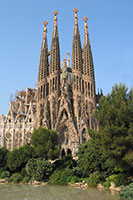
Sagrada Familia
Antoni Gaudí's Design
One year later, the modernist architect Antoni Gaudí took over as lead architect at the age of 31. From that moment on, Gaudí devoted most of his life to the construction of the church. Instead of sticking to the original plans, Gaudí changed the design drastically. The neo gothic style made way for Gaudí's trademark modernist style, which was based on forms found in nature. When he died in 1926 only
one facade (the nativity facade), one tower, the apse and the crypt were finished. Because Gaudí was constantly improvising and changing the design while construction was going on, he left few designs and models. And most of these were destroyed during the civil war in 1936.
18 Towers
Still, architects now have a clear idea of what Gaudí had in mind. The last version of his design called for a church 95m/312ft long and 60m/197ft wide. The church will be able to accommodate 13,000 people. When finished, the Sagrada Familia will have a total of 18 towers.
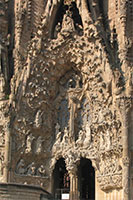
Detail of the Nativity Facade
Four Towers on each of the three facades represent the 12 apostles. The towers reach a height of 90 to 120m (394ft). Another four towers represent the 4 evangelists. They will surround the largest, 170m/558ft tall tower, dedicated to Jesus Christ. The last tower, dedicated to Virgin Mary, will be built over the apse.
Construction
After Gaudí's death in 1926 construction slowed dramatically due to a lack of funds and the civil war. Construction pace started to pick up again in the mid 1950s and now two facades and eight tower have been completed. The main nave was roofed in 2000.
Currently construction is mainly focusing on the nave and the main southern facade known as the
Glory Facade. This facade will picture life and death.
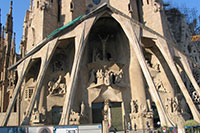
Passion Facade
The first facade, facing east, is known as the
Nativity Facade. It was finished by Gaudí himself and is ornamented in a baroque fashion with motifs of animals and plants.
Opposite the Nativity facade is the '
Passion Facade'. Construction started in 1954, but only in 1987 sculptures depicting the crucified Jesus Christ were added. As soon as they were installed, the abstract figures caused a storm of criticism, as the style was very different from Gaudí's.
Visiting Sagrada Familia
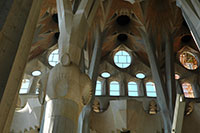
Interior
Even though the Sagrada Familia is far from finished, the remarkable church is well worth a visit. You can visit the crypt were Gaudí is buried. A museum tells the story of this great architect and the history of the church.
You can also visit the towers. A lift and a long walk will lead you to the top of a tower from where you have a magnificent view over Barcelona. The climb is not recommended for those with fear of heights or for people with claustrophobia!
La Rambla or Les Rambles is the most famous street in Barcelona. The wide boulevard connects the Plaça de Catalunya, a busy square, to the Monument a Colom, a tall column erected in honor of Christoffel Columbus.
The often crowded street is popular with tourists and locals alike. The middle part of the Rambla is pedestrianized and bordered by trees. Kiosks, flower stalls, animal stalls and street artists are in abundance here. Traffic passes on either side of the pedestrian area.
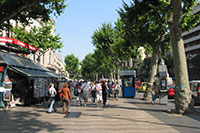
The Rambla
History
The Rambla was originally a small stream flowing just outside the city walls. In the 16th century convents and a university were built along the river. In the 19th century the city wall was torn down and buildings were erected along the now dried up river. The original buildings were torn down but they are remembered in some of the names of the five different parts of the Rambla. Even though it is one continuous street, it actually consists of five 'ramblas'.
Rambla de Canaletes
The first Rambla, starting from the Plaça de Catalunya, is the Rambla de Canaletes. The name originates from the 19th century Canaleta fountain. The expression 'he drinks water from Canaletes' means that person comes from Barcelona. And according to local legend, once you drink from the fountain, you will keep coming back to Barcelona.
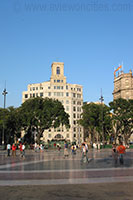
Plaça de Catalunya
Rambla dels Estudis
The second Rambla is the Rambla dels Estudis. It is named after the 16th century university, the Estudis Generals. The building was demolished in 1843. Several important buildings are still in this area, among them the 18th century Reial Acadèmia de Ciènces i Arts, since 1910 a theater. The building contains the first public clock of the city.
Rambla de Sant Josep
The next Rambla is the Rambla de Sant Josep, named after a convent which was demolished in the mid 1900s and replaced by the Mercat de Boqueria, a colorful market place. Since this part of the Rambla has many flower stalls, it is now better known as the Rambla de les Flors, or 'Flower Rambla'. At the end of this part of the Rambla is a small square, the Plaça de la Boqueria. It features a mosaic by Joan Miró and a shop decorated with an art-deco dragon.
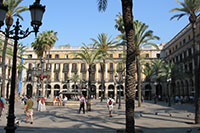
Plaça Reial
Rambla dels Caputxins
The fourth Rambla counting towards the Columbus Monument is the Rambla dels Caputxins, yet again named after a now demolished building: a Capuchin monastery.
The most interesting building on this rambla is the Gran Theatre del Liceu, a building decorated in modernista style. Fire destroyed Barcelona's Opera Theater twice, in 1861 and in 1994, but it was rebuilt each time, most recently reopening in 1999.
Further down the rambla on the left hand side is the entrance to the Plaça Reial, a 19th century lively square with tall palm trees and street lamps designed by Antoni Gaudí. Opposite the Plaça Reial, in the Carrer Nou de la Rambla is the Palau Guëll or Guëll Palace, one of Gaudí's first residential buildings. The parabolic shapes at the entrance and the rooftop chimneys are signs of things to come in his later works at the Guëll Park and the Casa Mila, just to name two of this catalan architect's most famous works.
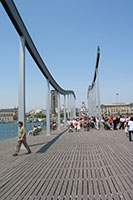
Rambla del Mar
Rambla de Santa Monica
The last Rambla is the Rambla de Santa Monica, named after a convent, now converted into a museum, the Centre d'Art Santa Mònica. The rambla leads to a roundabout with a 60m large column, the Columbus Monument. It was built in 1888 for the Universal Exposition.
Rambla de Mar
If you continue to walk in the direction of the Port Vell, a wooden walkway, now known as the Rambla de Mar or Rambla of the Sea, leads you to Maremàgnum, a complex with shops, movie theaters - including an IMAX theater - and a large aquarium.
Montjuïc
The Montjuïc is a hill located near the center of Barcelona. It features a large number of attractions including the Spanish Village and the Montjuïc Castle.
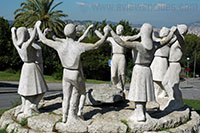
Sardana Monument
Today the hill features a large number of sights and attractions, most of them originating from two major events that took place here: the 1929 International Exhibition and the 1992 Olympics.
Mies van der Rohe Pavilion
Right next to the fountain is the Pavelló Mies van der Rohe, built by Ludwig Mies van der Rohe as the German pavilion for the 1929 Barcelona International Exhibition. Like all other pavilions, the German pavilion was demolished after the exposition, but since it is considered
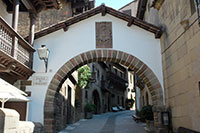
Poble Espanyol
one of van der Rohe's most influential works, it was reconstructed in the 1980s. The glass and marble building is typical for Mies van der Rohe's work, whose maxim was 'less is more'.
Poble Espanyol
Another remainder of the 1929 Exhibition is the Poble Espanyol (Spanish village), a collection of houses in different Spanish architectural styles. The village was originally slated for demolition after the end of the Exhibition, but due to its popularity it was kept intact. The Poble Espanyol is still a very popular tourist attraction.
Montjuïc Gardens
With the arrival of the Olympics in 1992, the many gardens on the Montjuïc were given renewed attention and since several new gardens were added. Some of the most interesting are the
Nou Jardí Botànic, a botanic garden with more than 2000 different plants created in the 1990s and the
Jardins de Mossen Costra i Lljobera, with hundreds of different types of cactuses.
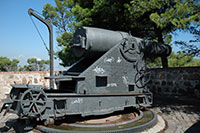
Artillery at the
Museu Militar
Castell de Montjuïc
The oldest sight on the Montjuïc is the Castell de Montjuïc, a large 18th century fortress. It was built by the Bourbons on the remains of a fort dating back to 1640. Originally built for the defense of Barcelona but often used against the city at the foot of the hill, the fortress now houses the Museu Militar (military museum). The fortress can be reached by a funicular and cable-lift, which starts at the Parallel metro stop.
Parc Guëll
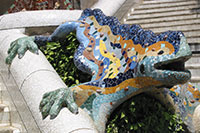
Mosaic Dragon
The Guëll park is one of the most intriguing parks in the world. The pavilions and main staircase designed by Antoni Gaudí look like they belong in some fairy tale.
A Failed Project
This popular park started out as a development project. Eusebi Guëll, a well known Catalan industrialist, acquired a 17ha / 42acre large hilly
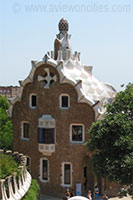
Pavilion
plot in the Gràcia district, north of Barcelona. He wanted to turn the area into a residential garden village based on English models. 60 Housing units as well as several public buildings were planned.
In 1900 Guëll commissioned his friend and protégé Antoni Gaudí with the development of the project. With the support from other architects including Josep M. Jujol and his disciple Francesc Berenguer, Gaudí worked on the garden village until 1914 when it was clear the project was a commercial failure: Guëll failed
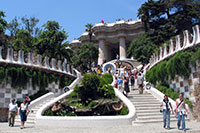
Staircase with Sala Hipòstila
to sell a single house. In 1918 the city acquired the property and in 1922 it was opened to the public as a park.
Gaudi's Staircase and Pavilions
Two houses were completed as well as pavilions for visitors and park keepers. The pavilions, designed by Gaudí, seem to be taken out of Hansel and Gretel, with curved roofs covered with brightly colored tiles and ornamented spires. The staircase at the entrance of the park is also designed by Gaudí. The dragon-like lizard at the center of the with
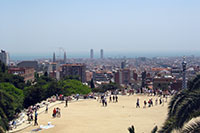
Gran Placa Circular
trencadis-ceramics decorated staircase is the best known symbol of the park.
Serpentine Bench
A connecting flight of stairs leads to another famous feature of the park: the Gran Placa Circular. Originally intended as a market place for the residents, this plaza is bordered by what is known as the largest bench in the world. The colorful ceramic serpentine bench, designed by Jujol, twists snakelike around the plaza. The view from the plaza is spectacular, you can see as far as the Mediterranean Sea. The whole
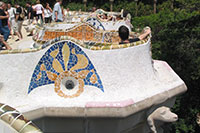
Serpentine Bench
platform is supported by 86 huge columns, creating a hall beneath the plaza, known as the Sala Hipòstila.
Gaudi Museum
Between 1906 and 1926, Gaudí lived in one of the two houses that were completed. The house, known as the Casa Museu Gaudí, was designed by Francesc Berenguer. It serves as a museum and displays some of Gaudí's furniture (including some from the Casa Batlló) and drawings. The park also includes the Casa Trias (not open for visitors) and winding roads with paths supported by tree-like columns. The Parc Guëll was declared a world heritage site by UNESCO in 1984.
Port Vell
Formerly an obsolete harbor, the Port Vell was turned into a modern yacht-basin and entertainment center.
Urban Renewal
Before the Barcelona Olympics in 1992, the Port Vell, the city's old obsolete harbor was only a run down area with empty warehouses, industrial buildings, refuse dumps and railroad yards. In one of the most drastic urban renewal projects, the area was transformed into a yacht basin and entertainment center, opening the city up to the sea. A coastal road was moved underground and a pedestrian street now stretches from the Columbus monument to the Barceloneta neighborhood.
The IMAX theater features three projection systems: the Omnimax screen, the flat IMAX and the 3D IMAX for which spectators use 3D glasses.
The biggest attraction of the Port Vell is the aquarium, one of the largest in Europe. The aquarium boasts 8000 Fish, including 11 sharks in in total 22 basins filled with 6 million liter (1,5 million gallons) sea water. Basin 17 features an 80m long tunnel from where you can observe mediterranean deep sea fish, including sharks.
Southwest of the Maremàgnum is the Aduana building, an old customs building constructed in 1902. Adjacent is a long pier with the new World Trade Center.
Head of Barcelona
At the other, north eastern end of Port Vell is an eye-catching statue by pop artist Roy Lichtenstein. The colorful 14m high statue is called 'El cap de Barcelona' (head of Barcelona).
Exposition Entrance

The Arc de Triomf is a triumphal arch built with colorful brickwork in mudéjar style. This beautiful arch was built for the 1888 Universal Exposition, which took place at the Parc de la Ciutadella. The Arc de Triomf, situated at the end of a wide promenade, served as the exposition's main entrance.
La Seu Cathedral

In the center of the Barri Gòtic (Gothic district), the heart of Barcelona, is the gothic cathedral, known as La Seu. The cathedral is officially named Cathedral de la Santa Creu i Santa Eulalia, after Barcelona's patron saint Eulalia.
Already in 343 A.D. during the Roman Empire a basilica was built at the site of the current cathedral. In 985 the basilica was destroyed by the Moors, led by Al-Mansur. It was replaced by a Roman cathedral, built between 1046 and 1058. A Roman chapel, the Capella de Santa Llucia, was added between 1257 and 1268. It was later incorporated in the cloister next to the cathedral.
Construction
30 Years later, in 1298, construction of the gothic cathedral started under King Jaume II, known as 'the Just'. During the construction of the gothic cathedral, the existing roman building was demolished except for the Santa Llucia chapel. Due to civil wars and the black death which hit the city several times, the construction only progressed slowly. It took until 1460 before the main building was completed. The gothic facade was finished much later, in 1889 and the last part, the central spire, was The La Seu Cathedral at night, Barcelona The Cathedral at night completed in 1913. The design of both the facade and the spire were based on the original design from 1408 by the French architect Charles Galters.The Christoffel Columbus The Christoffel Columbus was built in 1888 in honor of the renowned explorer and discoverer of America.
The Christoffel Columbus was built in 1888 in honor of the renowned explorer and discoverer of America. At the center of the Plaça de la Porta de Pau (Square of the Gate of Peace) stands a monumental column topped by a statue of Christoffel Columbus. The 60m / Monument197ft high monument, known as the Monument a Colom, was designed by Gaietà Buigas i Monravà for the Universal exhibition of 1888.
The monument is placed at the site where Christoffel Columbus arrived in 1493 after his discovery of America the year before. Columbus was presumably born in Genoa, Italy. He first moved to Portugal and later settled in Spain. Nevertheless in the 19th century Columbus was considered a Catalan - some historians still claimed he was born in Catalonia, hence the monument for the famous explorer in Barcelona.
Eixample
Considered to be one of the first examples of modern urban planning, Barcelona’s Eixample (meaning, literally, “extension” in the Catalan language) was developed in the second half of the 19th century.

Cerda’s plans for the Eixample were considered to be quite visionary. When designing the neighborhood, he took many things into consideration including traffic, sunlight, and ventilation. The streets were to broaden at each intersection and the corners were cut off to allow horse-drawn wagons to make turns Casa Terrades, Barcelona Casa Terrades more easily. However, all of Cerda’s plans didn’t turn out quite the way he had hoped. Architects did follow his grid plan, but ignored many of the specifics. The intersections weren’t designed as his drawings indicated (though they are spacious), garden areas were eliminated, and the neighborhood became a haven for the wealthy rather than a place that would attract all classes.
Casa Batlló 
You’ll want to make a stop at the magnificent Casa Batlló, a Gaudi-designed structure that’s on the UNESCO World Heritage list. The structure is nearly indescribable to those who haven’t laid eyes on it, but is truly one of the most incredible examples of Modernista architecture anywhere, covered with glittery pieces of glass and boasting interesting shapes throughout. You’ll also want to visit the Casa Milà, with its wavy walls which remind some of honeycombs and others of African cave dwellings. Strange-looking chimney stacks sit atop the building.
Magic Fountain
The Magic fountain is a large fountain built in 1929. When the fountain is active, it constantly changes color and shape. The Font Màgica or Magic fountain was part of a project built for the 1929 Universal Exhibition. The exhibition took place on Montjuïc, a hill on the eastern end of Barcelona.
Cascades and Fountains
The project, designed by the engineer Carles Buigas consisted of a series of cascades and fountains between the Palau National, the main exhibition center on the Montjuïc, and the Plaça d'Espanya at the foot of the hill. It took one year to complete the project. The most spectacular part was the monumental Magic fountain. It was originally intended to show people what could be achieved with filtered electrical light.
Palau Nacional

Barcelona’s Palau Nacional appears, at first glance, to be a very grand, old building. Looks can be deceiving! This sprawling structure that houses the National Art Museum of Catalonia was actually built in 1929 for the International Exhibition.
About the Building The Palau Nacional was the flagship of the 1929 Exhibition, drawing lots of attention from the crowds that descended upon the Catalan region for the event. Built in the style typical of palaces that housed European royalty, Palau Nacional it was designed by architects Enric Català i Català and Pedro Cendoya Oscoz. The building recently underwent major renovations at the hands of architects Gae Aulenti and Josep Benedito, though the magnificent Oval Hall was renovated in 1992 and opened in time for the summer Olympics, held in Barcelona that year.
Parc de la Ciutadella

The Parc de la Ciutadella is Barcelona's most central park. The park includes a zoo, a lake, a large fountain and several museums. The Catalan Parliament is seated at a building in the center of the park.
The Citadel In 1714, after a 13 month long siege, Barcelona fell to the army of Philips V during the war of the Spanish Succession. In order to keep firm control over Barcelona, King Philips V built the largest fortress in Europe, a star-shaped citadel or 'Ciutadella'. A large part of the the Ribera district was demolished for this fortress. Only 30 years later was the neighborhood rebuilt at another location as the 'Barceloneta'.
The Cascada

At the northern corner of the park is the Cascada, a triumphal arch with waterfall and fountain built for the 1888 Universal exhibition. The baroque construction designed by Josep Fontsère, responsible for the conversion of the citadel site into a park, took six years to complete. The design was loosely based on the Trevi Fountain in Rome. The architect was assisted by Antoni Gaudí, at the time still a student.
Parc de l'Espanya Industrial

Creation The 4.6ha (11 acres) large park was created in 1985 on the site of Vapor Nou, a former textile factory. Locals called the factory L'Espanya Industrial, hence the name of the park. The development of the park was part of a plan by Barcelona's city council to create more open spaces. The modern design by the Bask architect Luis Pena Ganchegui fits well in the environment, defined by the large railway station, wide roads and high-rise buildings.
Miró

Joan Miró was born in Barcelona in 1893 and studied at the Barcelona School of Fine Arts and the Academia Galí. His early works were reminiscent of Catalan folk art, yet one could detect the flavor of cubism in his paintings. After he moved to Paris and studied there in the 1920s, he began to develop what was to become his signature style, Surrealism. He also experimented with other media besides painting, including etchings, lithographs, and ceramic sculptures. Miro died in 1983.
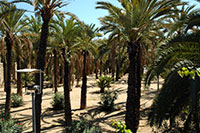
Parc Joan Miró
The Park
The area where Parc Joan Miró now sits was, until 1979, the location of the municipal slaughterhouse. Because of that, it is sometimes referred to as Parc de l'Escorxador.
Covering four city blocks, this expansive park consists of two levels. The lower level is landscaped with pine, palm, and fragrant eucalyptus trees and colorful flowers, especially during the spring and summer months. The lower level is paved and contains the park's crowning glory, one of Joan Miró's last sculptures, entitled Dona i Ocell (Woman and Bird).
The Plaça de Catalunya

A large plaza surrounded by monumental buildings, is Barcelona's busiest square. It is located between the old city (Ciutat Vella) and the 19th century Eixample district Barcelona's two most famous streets, the Rambla (a wide promenade in the old city) and the Passeig de Gracia (a grand showcase of modernist architecture in Eixample) start at the Plaça de Catalunya. Even though the square is enormous in size, it is constantly crowded with people walking to and from one of the nine streets emanating from the square.
Transportation Hub
The Plaça de Catalunya also functions as a hub for the city's public transportation. Below the square is the main subway junction; three metro lines and a city railway line meet here. Many of the city's buses, as well as airport express and tourist buses stop here at the square.
Until the middle of the 19th century the Plaça de Catalunya was a rural area just outside the city walls. In 1858 the central government in Madrid finally allowed the defensive walls to be demolished. It also approved construction outside the walls so a public competition was organized for the design of a new district.
Eixample Masterplan
The first place was awarded to a design by Rovira i Trias, which consisted of plan with streets radiating from the historic Barri Gotic district. The central government however chose for a more modern design with a grid plan by Ildefons Cerdà.
The central government prevailed and the new Eixample district was designed according to Cerdà's design. Barcelona's government however opposed what they perceived as a lack of integration between the new and old districts. They supported Rovira i Trias's plan of a wide esplanade leading to a plaza. Cerdà's plan consisted of an extension of the Rambla towards a large square to be created on the Passeig de Gracia.
Final Design
Eventually the local and central government agreed to another plan as a compromise.
The new design by the architect Puig i Cadafalch (better known for his modernist building 'Casa de les Punxes') resulted in the current enormous square, created between 1925 and 1927.
ça de Catalunya is not integrated with any of the surrounding neighborhoods, but for a square this size it is surprisingly pleasant.
The benches at the circular center of the square are ideal for people-watching. Around this centrally paved area a couple of fountains and a large number of sculptures are planted, seemingly at random.
A recent addition to the square's collection of sculptures is the Monument a Francesc Macià, honoring the former president of the Generalitat (the Catalan government). The sculpture was created in 1991 by Josep Subirachs, the architect in charge of the construction of the Sagrada Familia.
Plaça d'Espanya
The Plaça d'Espanya was created for the 1929 World Exhibition. Designed in 1915 by the architect Josep Amargós, it was only completed just in time for the exhibition.
Another architect, Josep Maria Jujol designed a large fountain at the center of the square. His modernist style is clearly influenced by Gaudi, with whom Jujol frequently collaborated on projects like the Casa Milà and Park Guëll. The sculptures adorning the fountain were created by the Spanish sculptor Miguel Blay Fabregas.
Venetian Towers
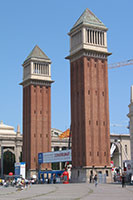
Venetian Towers
A wide avenue, the Avinguda de la Reina María Christina, is flanked by two towers and leads to the Magic fountain and the Palau National at the Montjuïc. The avenue is often used for trade fairs. The 47m / 154ft high towers are modeled on the Bell Tower at the St. Mark's Square in Venice. They were built by Ramon Raventós for the 1929 International Exhibition.
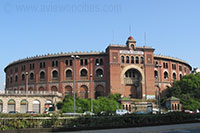
Arenas de Barcelona
Arenas de Barcelona
At the other end of the Plaça d'Espanya stands the 'Arenas de Barcelona'. The bullring in Mudéjar style brickwork was built in 1900. But bullfights have never really caught on in Catalonia and the arena is now being turned into a shopping center.
Parc de Joan Miró
The area behind the arena is known as the Parc de l'Escorxador or Park of the abattoir
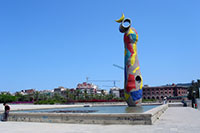
Parc de Joan Miró
as it was used as the abattoir for the bullring.
In the 1980s the park was renamed Parc de Joan Miró after the local artist who left his mark on the square with a 22m high colorful sculpture, known as 'Dona i Ocell' or Woman and Bird.
Originally the idea was to put a forest of sculptures like these in the park, but Joan Miró's death in 1983 prevented these plans from being implemented.
Poble Espanyol

Creating a Village
A team of two architects, an engineer and an artist created the Poble Espanyol by building 116 buildings in different architectural styles representing Spain's many regions. The village features a large square, the Plaza Mayor, and a couple smaller squares connected by picturesque streets, some with stairs. It includes a town hall, a church, a monastery, shops and residential buildings.
Replicas
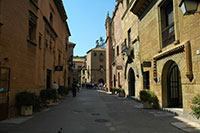
Caballeros Street
Several of Poble Espanyol's buildings are exact reproductions of existing buildings, while other merely represent a specific architectural style. The main entrance gate to the village is a replica of the Puerta San Vicente, one of nine gates of the 11th century walls around the city of Avila. Some other notable replicas are the Town Hall of Valderrobres and the tall clock tower of Utebo, a mixture of Mudéjar and gothic styles.
A Popular Attraction
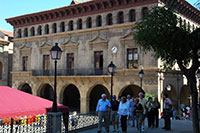
Valderrobres Town Hall
El Poble Espanyol was only built for the duration of the Exhibition, but due to its popularity it was not demolished. Except during Spain's civil war, when it was used as an internment camp for prisoners, it has continued to attract visitors lured by the car-free idyllic village.
The Village Today
In 1988 the village was renovated and several attractions were added. There is now a focus on traditional arts with artisans creating glass, decorative paintings, ceramics, embroidery, and many other handmade objects in about 40 workshops. The village also features a number of bars, restaurants, shops and even some nightclubs.
Torre Agbar 
While the inside is certainly structurally interesting, it’s the exterior that fascinates passers-by as they make their way down the highways of Barcelona. The first skin that covers the concrete
structure is a layer of polished aluminum in blues, greens, and grays. The second skin, which adds an iridescent sparkle to the building, is made up of 59,619 sheets of clear glass.
There are 4,400 windows accompanied by louvers that tilt in various directions to block out any direct sunlight. At night, the tower becomes yet more magnificent, with 4,500 yellow, blue, pink, and red lights illuminating the exterior.
TransportationAirports
Barcelona is served by Barcelona Airport in the town of El Prat de Llobregat, about 17 km (11 mi) from Barcelona. It is the second-largest airport in Spain, and the largest on the Mediterranean coast. It is a main hub for Vueling Airlines and Clickair, and also a focus for Spanair, Air Europa and Iberia. The airport mainly serves domestic and European destinations, but some airlines offer destinations in Asia and the United States. The airport is connected to the city by highway, commuter train and scheduled bus service. The airport handled 32,800,570 passengers in 2007. A new terminal (T1) has been built, and entered service on 17 June 2009.
Sabadell Airport is a smaller airport in the nearby town of Sabadell, devoted to pilot training, commercial flights, aerotaxi and private flights. Some low-cost airlines, like Ryanair and Martinair, prefer to use Girona-Costa Brava Airport, situated about 90 km (56 mi) to the north of Barcelona and Reus Airport, situated 77 km (48 mi) to the south.
Seaport
The Port of Barcelona has a 2000-year history and a great contemporary commercial importance. It is Europe's ninth largest container port, with a trade volume of 2.3 million TEU's in 2006. The port is managed by the Port Authority of Barcelona. Its 7.86 km2 (3 sq mi) are divided into three zones: Port Vell (the Old Port), the commercial port and the logistics port (Barcelona Free Port). The port is undergoing an enlargement that will double its size thanks to diverting the mouth of the Llobregat river 2 km (1¼ mi) to the south.
The Port Vell area also houses the Maremagnum (a commercial mall), a multiplex cinema, the IMAX Port Vell and an aquarium.
Public transport
Barcelona is served by a comprehensive local public transport network that includes a metro, a bus network, two separate modern tram networks, a separate historic tram line, and several funiculars and aerial cable cars. The Barcelona Metro network comprises nine lines, identified by an "L" followed by the line number as well as by individual colours. Most of the network is operated by the Transports Metropolitans de Barcelona (TMB), but three lines are FGC commuter lines that run through the city. When finished, the L9 will be the second longest underground metro line in Europe with 42.6 km; only shorter than London's 76 km Central Line.
TMB also provides most of the services of the city's daytime bus network, as well as a tourist bus service. The tourist bus service gives the opportunity to visit the city on open-topped double-decker buses. The Barcelona Bus Turistic runs along three sightseeing routes, and passengers can get on and off as many times as they like. The night bus network, known as Nitbus, is operated by Tusgsal and Mohn. Transports Ciutat Comtal operates the Aerobus (to the airport) and the Tibibus (bus from Plaça Catalunya to Tibidabo amusement park) services. Other companies
Another company, TRAMMET, operates the city's two modern tram networks, known as Trambaix and Trambesòs. The historic tram line, the Tramvia Blau, connects the metro to the Funicular del Tibidabo. The Funicular de Tibidabo climbs the Tibidabo hill, as does the Funicular de Vallvidrera. The Funicular de Montjuïc climbs the Montjuïc hill. The city has two aerial cable cars: one to the Montjuïc castle and another that runs via Torre Jaume I and Torre Sant Sebastià over the port.
Barcelona is a major hub for RENFE, the Spanish state railway network, and its main intercity train station is Barcelona-Sants station. The AVE high-speed rail system was recently extended from Madrid to Barcelona. Renfe cercanías/rodalies and the Ferrocarrils de la Generalitat de Catalunya (FGC) run Barcelona's widespread commuter train service. The Estació del Nord (Northern Station), a former railway station that was renovated for the 1992 Olympic Games, now serves as the terminus for long-distance and regional bus services.
Barcelona has a metered taxi fleet governed by the Institut Metropolità del Taxi (Metropolitan Taxi Institute), composed of more than 10,000 cars. Most of the licences are in the hands of self-employed drivers. With their black and yellow livery, Barcelona's taxis are easily spotted.
On 22 March 2007, Barcelona's City Council started the Bicing service, a bicycle service understood as a public transport. Once the user has their user card, they can take a bicycle from any of the 100 stations spread around the city and use it anywhere the urban area of the city, and then leave it at another station. The service has been a success, with 50,000 subscribed users in three months.



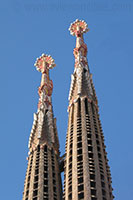


























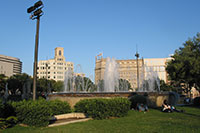
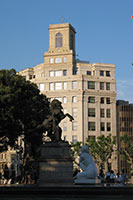
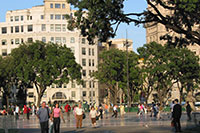
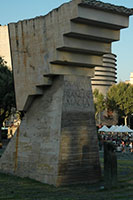











No comments:
Post a Comment